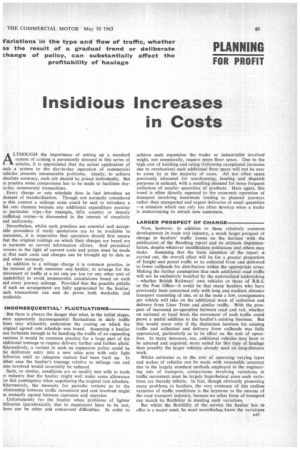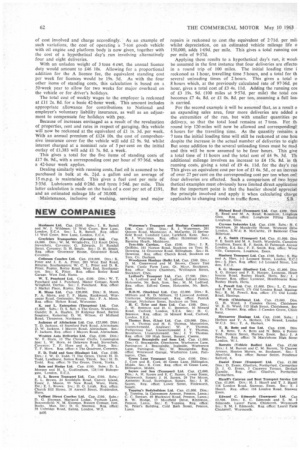Insidious Increases in Costs
Page 63

Page 64

If you've noticed an error in this article please click here to report it so we can fix it.
ALTHOUGH the importance of setting up a standard system of costing is persistently stressed in this series of articles, it is appreciated that the actual application of Judi a system to the day-to-day operation of commercial vehicles presents innumerable problems. Ideally, to achieve tbsolute accuracy, each job should be priced individually. But m practice some compromise has to be made to facilitate daya)-day commercial transactions.
Every charge or rate schedule does in fact introduce an :lement of standardization. Though not normally considered .n this context a mileage scale could be said to introduce a flat rate element because any additional expenditure peculiar :o particular trips—for example, hilly country or densely trafficked routes—is discounted in the interest of simplicity Ind uniformity.
Nevertheless, whilst such practices are essential and acceptable procedure if ready quotations are to be available to :ustomers, it is imperative that operators should first ensure :hat the original costings on which their charges are based are is accurate as current information allows. And periodical -eviews in the light of current costs and prices must be made io that such costs and charges can be brought up to date as ind when necessary.
In addition to a mileage charge it is common practice, in :he interest of both customer and haulier, to arrange for the movement of traffic at a set rate per ton (or any other unit of oadability) to avoid innumerable calculations based on each Ind every journey mileage. Provided that the possible pitfalls )f such an arrangement are fully appreciated by the haulier, ;itch transactions can and do prove both workable and mofitable,
INCONSEQUENTIAL' FLUCTUATIONS But there is always the danger that what, in the initial stages, were apparently inconsequential fluctuations in daily traffic lows may ultimately undermine the costing on which the miginal agreed rate schedule was based. Assuming a haulier was fortunate enough to be handling the traffic of an expanding )usiness it would be common practice for a large part of the tdditional tonnage to require delivery farther and farther afield. 4,Iternatively, a variant in such an expansion policy could be he deliberate entry into a new sales area with only light ieliveries until an adequate custom had been built up. In Ater case the haulier's tonnage relative to mileage run and ime involved would invariably be reduced.
Such, or similar, conditions are so readily met with in trade mi. industry that the haulier might well make some allowance or this contingency when negotiating the original rate schedule. klternatively, the necessity for periodic reviews as to the -elationship between traffic movement and cost involved might )e mutually agreed between customer and operator.
Unfortunately for the haulier when problems of lighter leliveries (paradoxically due to expansion) have to be met, here can be other and concurrent difficulties. In order to achieve such expansion the trader or industrialist involved might, not unnaturally, require more floor space. Due to the high cost of building and rating (following exceptional increases due to revaluation) such additional floor space will not be easy to come by in the majority of cases. All too often space previously allocated for warehousing, loading and dispatch purposes is reduced, with a resulting demand for more frequent collection of smaller quantities of products. Here again, this trend is often directly opposed to the economic operation of transport involving maximum loading to planned journeys rather than unexpected and urgent deliveries of small quantities —a situation which can only too often develop when a trader is endeavouring to attract new customers.
LARGER PROSPECT OF CHANGE Now, however, in addition to these relatively common developments in trade and industry, a much larger prospect of change in hauliers' traffic looms on the horizon with the publication of the Beeching report and its ultimate implementation, despite whatever modification politicians and others may make. Assuming that the basic intention of the report ts carried out, the overall effect will be for a greater proportion of freight and parcel traffic to be collected from and delivered to fewer railheads for distribution within the appropriate areas. Making the further assumption that such additional road traffic will not be exclusively handled by the nationalized undertaking —whether British Railways' own vehicles or those of B.R.S. or the Post Office—it could be that many hauliers who have previously been concerned only with long and medium distance transport consisting of one, or at the most a few, consignments per vehicle will take on the additional work of collection and delivery from Liner Train and similar traffic. With the prospect of increased co-operation between road and rail, whether on national or local level, the movement of such traffic could prove a useful addition to the haulier's existing business. But this would occur only if the distinction between his existing traffic and collection and delivery from railheads was fully appreciated, particularly as to its effect on the cost of operation. In many instances, too, additional vehicles may have to be selected and acquired, more suited for this type of haulage than possibly the larger vehicles already used on long-distance work.
Whilst estimates as to the cost of operating varying types and makes of vehicles can be made with reasonable accuracy due to the largely standard methods employed in the engineering side of transport, comparisons involving variations in traffic movement must be largely hypothetical since such variations are literally infinite. In fact, though obviously presenting many problems to hauliers, the very existence of this endless variation of traffic conditions is the keystone to the success of the road transport industry, because no other form of transport can match its flexibility in meeting such variations.
But whilst the flexibility of the service the haulier has to offer is a major asset, he must nevertheless know the variations n45 of cost involved and charge accordingly. As an example of such variations, the cost of operating a 7-ton goods vehicle with oil engine and platform body is now given, together with the cost of a hypothetical day's run involving alternatively four and eight deliveries.
With an unladen weight of 3 tons 4 cwt. the annual licence duty would amount to £46 10s. Allowing for a proportional addition for the A licence fee, the equivalent standing cost per week for licences would be 19s. 5d. As with the four other items of standing costs, this calculation is based on a 50-week year to allow for two weeks for major overhaul on the vehicle or for driver's holidays.
The total cost of weekly wages to the employer is reckoned at £11 2s. Bd. for a basic 42-hour week. This amount includes appropriate allowance for contributions to National and employer's voluntary liability insurance, as well as an adjustment to compensate for holidays with pay.
Because of increases envisaged as a result of the revaluation of properties, rent and rates in respect of garaging, this vehicle will now be reckoned at the equivalent of Ll is. 3d. per week. With an annual premium of E124 10s. the cost of comprehensive insurance cover for the vehicle will add £2 9s. 9d. whilst interest charged at a nominal rate of 5 per cent on the initial outlay of £1,383 will add El 7s. 8d. a week.
This gives a total for the five items of standing costs of £17 Os. 9d., with a corresponding cost per hour of 97.36d. when a 42-hour week applies.
Dealing similarly with running costs, fuel oil is assumed to be purchased in bulk at 4s. 21d. a gallon and an average of 15 m.p.g. is maintained. This gives a fuel cost per mile of 3.35d. Lubricants add 0.28d. and tyres 1-54d. per mile. This latter calculation is made on the basis of a cost per set of £191, and an estimated mileage life of 30.000.
Maintenance, inclusive of washing, servicing and major repairs is reckoned to cost the equivalent of 2.71d. per mil4 whilst depreciation, on an estimated vehicle mileage life 0 150,000, adds 1.69d. per mile. This gives a total running cos per mile of 9.57d.
Applying these results to a hypothetical day's run, it woult be assumed in the first instance that four deliveries are effectet in a round trip of 100 miles. The initial loading time i reckoned as 1 hour, travelling time 5 hours, and a total for th several unloading times of 2 hours. This gives a total o 8 hours which, at the previously calculated rate of 97.36d. pe hour, gives a total cost of £3 4s. 11d. Adding the running cos of £3 19s. 9d. (100 miles at 9.57d. per mile) the total cos becomes £7 4s. 8d. or £1 Os. 8d. per ton, assuming a full low is carried.
For the second example it will be assumed that, as a result o an expanding sales area, four more deliveries are added a the extremities of the run, but with smaller quantities pe delivery, so that the total load remains at 7 tons, For th round trip 120 miles will now be allowed and correspondingl: 6 hours for the travelling time. As the quantity remains a
7 tons the initial loading time will still be reckoned at one hou despite the increase in the actual number of deliveries to eight But some addition to the several unloading times must be mad and this will be now assumed to be four hours. This give a total time of 11 hours and the total cost of £4 9s. 3d. Th additional mileage involves an increase to £4 15s. 8d. in th running costs, giving a total of £9 4s. lid, for the day's run This gives an equivalent cost per ton of £1 6s. 5d., or an increas of over 27 per cent on the corresponding cost per ton when onl. four deliveries are effected. Such a comparison of two hypo thetical examples must obviously have limited direct application But the important point is that the haulier should appreciat the principle involved and apply it when calculating charge
applicable to changing trends in traffic flows. S.B.
































































































